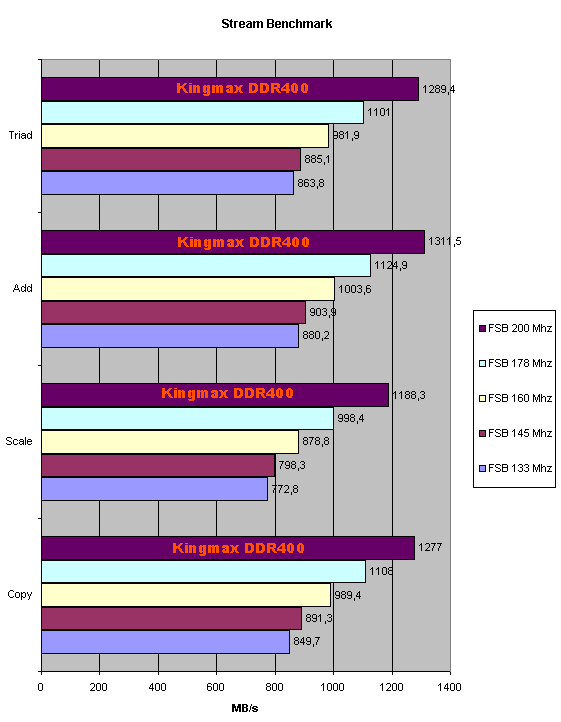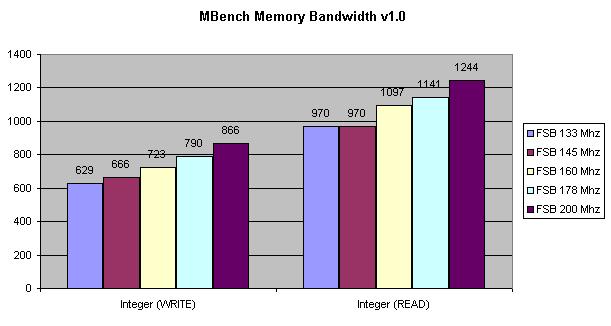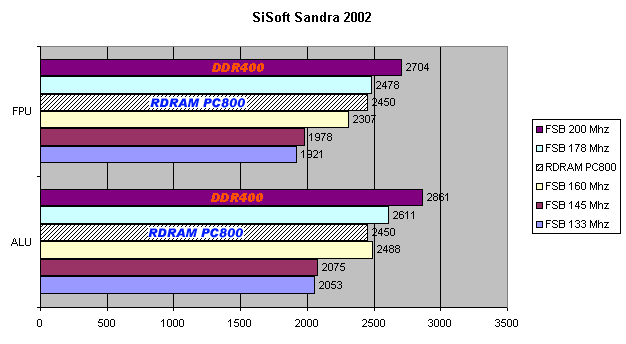
| Summary : |
![]()
[AMD] Synchronous Benchmark results
In order to analyse the relation between the performance evolution and the memory, we did our testing in the following five configurations :
- FSB 133 Mhz - Coef : 12x => 1600 Mhz (1900+)
- FSB 145 Mhz - Coef : 11x => 1595 Mhz (1900+)
- FSB 160 Mhz - Coef : 10x => 1600 Mhz (1900+)
- FSB 178 Mhz - Coef : 9x => 1602 Mhz (1900+)
- FSB 200 Mhz - Coef : 8x => 1600 Mhz (1900+)
This way, all tested configurations where working with a CPU running at 1600MHz (with 0.4% tolerance). We needed Benchmarks capable of delivering extremely accurate test results, we choosen following :
- WStream : Wstream (win 32 version of the famous StreamD) is a program able to calculate the module latency and the data troughput performance with the execution of some advanced mathematical operations. For detailled information about the way it works we refer you to this link. In order to void errors due to operating system failure we executed this test with a thousand iterations.
- Mbench : Mbench was specially developped for this test by Franck. The operation is quite similar to the previous benchmark testing, but in addition it makes it also possible to calculate the memory latency and the data throughput under INT-mode (FPU), MMx and SSE. As per his creator, this might once uppon a time replace the old-fashioned StreamD.
- SiSoft Sandra 2002 : Even that the results offered by Sandra are not allways extremly accurate, this program will allow us to compare the results with a wide variety of systems. More, Sandra has become a kind of default benchmark, therefore we could not exclude this one from our testings
- Quake 3 : We also needed a practical and concrete application, therefore we rejected all benchmark tests wich rely on other elements than the system memory (Benchmarks like Sysmark or Winstone can easely be influenced by other system components such as the PCI-bus, wich allow once you overclock this one, to increase your harddisk performance) To resume, the Quake 3, is very sensitive and rely completely on the available data troughput offered by the system, wich allows us to obtain some practical comparison chart.
-= StreamD =-
The results offered by StreamD are composed as following : Copy [ a(i)
= b(i) ] , Scale [ a(i) = q*b(i) ] , Sum [ a(i) = b(i) + c(i) ] et Triad
[ a(i) = b(i) + q*c(i) ]. We compared the results obtained with our five
different platforms :

Like you can see on the above Graphic, and the fact we are working with a fixed CPU speed at 1.6GHz, confirms the really impressive gain in performance compared to regular DDR266.
-= Mbench =-
So this Benchmark, Mbench, was specially developped for the purpose of
this test. Most interesting feature here was the ability to calculate
the INT wich void the CPU of being influenced by the chipset instructions
:

Even the fact that the differences seem to be less important than what a StreamD benchmark offers, we notice like we already expected that here also the DDR400 becomes the absolute winner. Regarding the fact that there seems to be no performance increase between the 133MHz FSB and the 145MHz FSB (970MB/S), because of the fact that this phenomenon comes back in the other banchmarks, we suppose this might be caused by some bug either in the BIOS or on the motherboard. This minor probleme besides, let's take a look at the latencies with these different frequencies :
|
FSB
|
Latence (en ns)
|
| 133 Mhz |
121.6
|
| 145 Mhz |
120.1
|
| 160 Mhz |
100.9
|
| 178 Mhz |
86.7
|
| 200 Mhz |
71.1
|
Besides the results at 133MHz and 145MHz you can notice the excellent performance at 200MHz (71.1nS)
-= SiSoft Sandra 2002 =-
The results we obtained with, SiSoft Sandra 2002, where very impressive. For instance the Rambus with his dual-channel operation, was simply blast away by this single-channel DDR400-SDRAM. In comparison we added the Rambus test results offered by SiSoft. For information all these results where obtained in SSE buffered mode, wich is since 2002 the default mode of the Sandra benchmark.

Besides the equal performance between 133MHz and 145MHz, you can see here that the 100MHz FSB of the PC800 Rambus with the i850 chipset can withstand the comparison with DDR up to a 178MHz FSB. But once you will use the DDR400 it really becomes the lethal weapon, blasting away all Rambus established benchmarks, one by one, with a very respectable 2.86GB/S for a theoretical 3.2GB/S.
-= Quake 3 =-
After all those theories, there is nothing better than a good practical
testing, here done with Quake 3, here you will really experience all the
benefit and profit you can obtain with this Kingmax DDR400

321FPS with Quake 3 fastest and 288FPS under Quake 3 normal (640x480) !!! These are really the best performances we noticed untill now. The benefits of the performance realised by this DDR400 are absolutly clear, and represents a fore-taste of what will be the requirements of your future graphic games, who will probably kick this Quake 3 right into the category of low performance kindergarten tools… J
Anyway, hereby we experienced how phenomenal was the performance increase
offered by this Kingmax DDR400. Unfortunatly, it seems to be unlikely
that a manufacturer such as AMD will be able to bring us in the coming
year a CPU with a 200MHz System Bus. In the main time we will have to
rely on desynchronised platform such as offered with the VIA KT400, wich
will never be able to reach the results of a synchronised platform. The
exceptional performances we obtained with the AMD is only due to the fact
that the EV6 bus, once running at the 200MHz bus, will unlock the RAM,
allowing the DDR to operate at highest performance.
Next ( Methodology of test: Intel-platform, Synchronous mode )